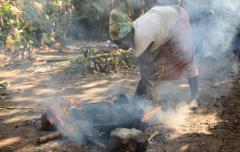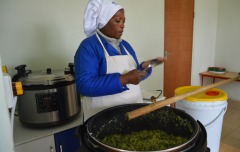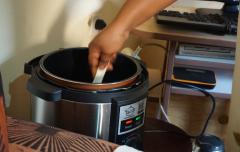Innovation in clean cooking: solving the challenge of fuel distribution
By Sophie Odupoy, KOKO Networks
Governments across Africa recognize the importance of clean renewable energy in achieving their strategic visions for economic and social development. Many countries, including Kenya, have mainstreamed the Sustainable Development Goals (SDGs) into national development plans.
But there’s still an elephant in the room, one which has seen me move away from the public sector to work in the very room where that elephant sits.
Because, even as electrification rates across the African continent have jumped over the last decade, driven by renewable options like solar home systems, the deadly use of charcoal for cooking is increasing exponentially as countries rapidly urbanize.
This despite decades of well-intentioned efforts across the development sector. The alarming reality is that billions continue to face no viable alternative to dirty cooking fuels. The associated health, gender and environmental statistics are widely publicized, and damning.
First, a cheerful note. Across Kenya and so many emerging markets, the exponential rise of solar home systems has been transformative for millions of consumers, who have been able to improve their lives and move beyond kerosene lighting.
Institutional capital has flowed into innovative companies which, coupled with the advancement of customized technologies such as improved solar batteries, has spurred the industry’s growth to be a key part of the sustainable energy for all agenda.
Such progress towards clean household energy is rightly applauded – affordable solar electricity is a lifeline to off-grid communities around the world.
However, if we are serious about achieving the goals of Sustainable Development Goal 7 (SDG7), we need to broaden our lens and demand faster action in scaling clean cooking solutions as well as electrification.
I have interacted with so many citizens in Kenya over the years who have no choice but to use charcoal or even kerosene for household cooking due to financial constraints and a lack of access to modern, clean, affordable solutions. They have simply learned to live with the negative effects of dirty fuel use.
But I’m captivated by the power of technology to improve the lives of lower-income consumers. Tackling this crisis requires innovators to reimagine traditional supply chains and determinedly focus on customer needs because the numerous approaches taken to date clearly haven’t worked.
As I’ve learnt since joining KOKO Networks in Nairobi earlier this year, this doesn’t mean reinventing the wheel.
Although a nascent industry, bioethanol cooking isn’t new; it’s been shown to deliver on the core consumer demands of cleanliness, modernity, safety and convenience in various commercial pilot projects around the globe.
Equally, other liquid fuels are distributed at scale all over Africa by specialist fuel companies, using billions of dollars of dedicated infrastructure. And for last-mile distribution, local communities in countries across the continent are served by millions of small shops and convenience stores close to home.
Designing to meet the vast consumer demand for modern and affordable cooking solutions, it is, therefore, logical to partner with market incumbents, leveraging existing infrastructure.
To overcome traditional last-mile distribution challenges, however, innovation has been critical in connecting otherwise disparate players in the value chain. New models eliminate the bottling facilities and associated packaging, distribution and retail costs that have traditionally driven bioethanol consumer prices higher.
Now, a new energy industry has emerged, bioethanol “2.0”, centred on developing technologies to work in tandem with existing supply chain infrastructure.
Kenya is the global leader in this new industry, although it was originally the milk industry in India that provided some inspiration.
Like bioethanol, milk is an expensive liquid to produce. Milk entrepreneurs in emerging markets needed to meet the same challenge of serving customers with a safe product at the lowest possible cost.
Rather than package the milk, innovators developed the notion of Milk ATMs. Urban customers simply bring their own clean canister, a pre-purchased token, and buy clean refrigerated milk dispensed from a dedicated ATM.
By applying this logic to bioethanol, there is now a way to safely move and store fuel in small bulk form, within a short walk of everybody’s home, and safely dispense it to customers into their own reusable canisters (removing the need for single-use plastic bottles).
So, this proven, decades-old model for urban distribution of expensive liquids, combined with modern Internet of Things technologies, dramatically increases the efficiency, visibility and control of the last-mile distribution of liquid bioethanol in cooking fuel.
The cost savings in distribution, inventory management, retailer management and customer engagement are passed through to the consumer, meaning that liquid bioethanol can easily undercut charcoal on price.
This model is working at scale in Nairobi, where more than 150,000 households are now using ultra-clean fuel that is 50 percent cheaper than charcoal.
Commercially scalable models for the distribution of clean cooking fuel (not just the cookstove itself) are essential if we are to meet our global commitment to SDG7.
The building blocks of a large-scale transition to clean bioethanol cooking across Africa are in place. Now is the time for institutional capital flows and policies customized for this specific fuel type that enable investment in the industry’s growth, as has already occurred in the electrification space.
After all, we humans lived in the dark for millennia but have always found ways to put heat energy into food. Access to affordable clean cooking energy in the developing world is perhaps the most fundamental human issue in the transition to a true green future.
Sophie Odupoy is Head of Public Affairs at KOKO Networks, based in Nairobi, and the former Director of Strategy and Communications at Kenya’s Vision 2030 Delivery Secretariat




